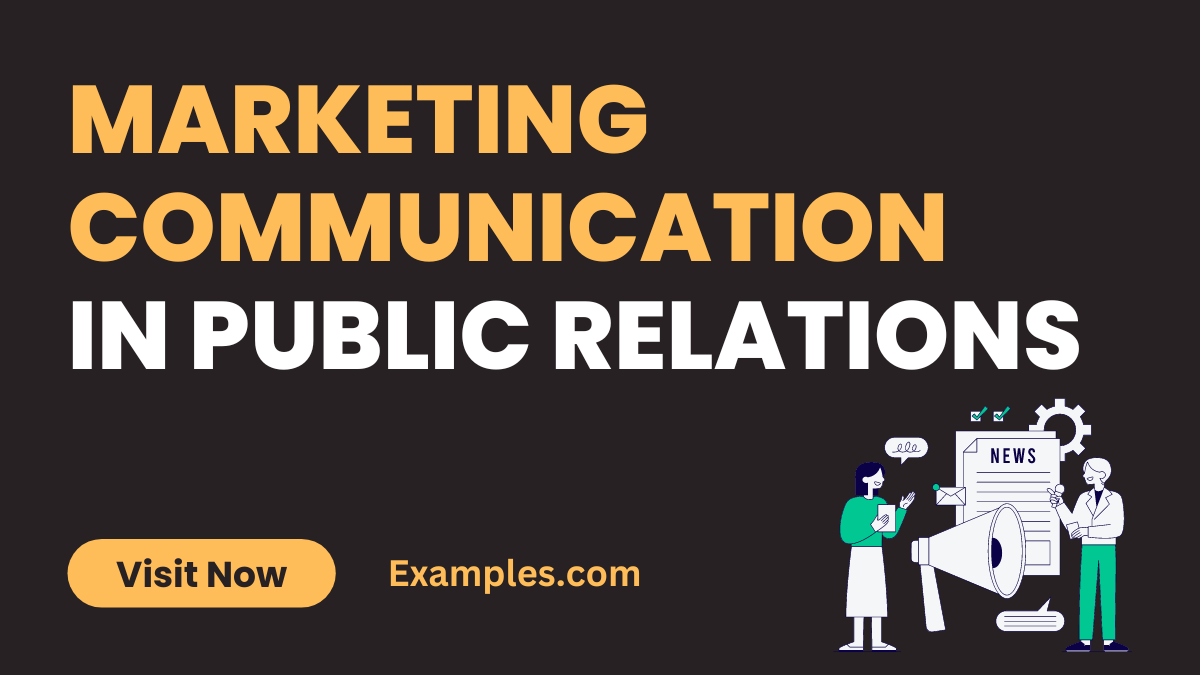19+ Marketing Communication in Public Relations Examples
Unlock the potential of Marketing Communication in Public Relations with our comprehensive guide. This essential resource delves into the heart of effective PR strategies, offering practical examples and insights. Learn how to craft compelling messages that resonate with audiences and foster strong relationships. Whether you’re a seasoned professional or new to the field, this guide is your key to mastering the art of communication in public relations.
What is Marketing Communication in Public Relations
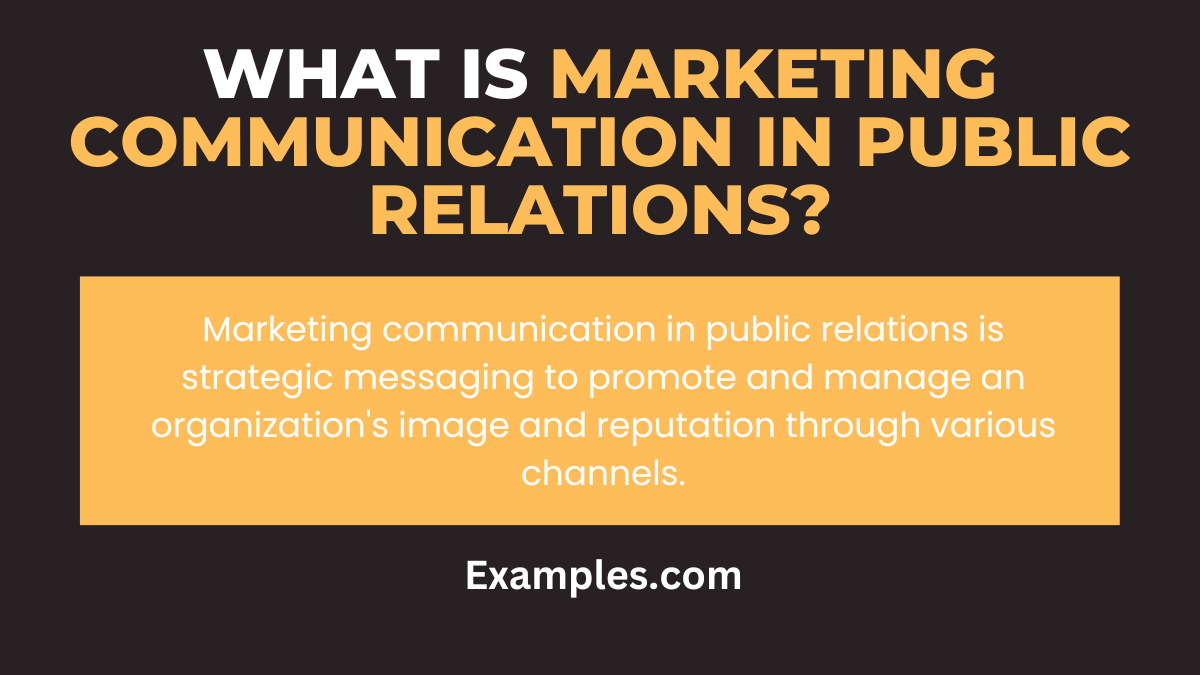
Marketing communication in public relations refers to the strategic use of various communication channels to build and maintain a positive image for a company or organization. It involves crafting and disseminating messages that align with the organization’s goals and resonate with its target audience. This communication strategy plays a crucial role in shaping public perception and can include elements such as media releases, social media campaigns, and event promotions.
What is the Best Example of Marketing Communication in Public Relations?
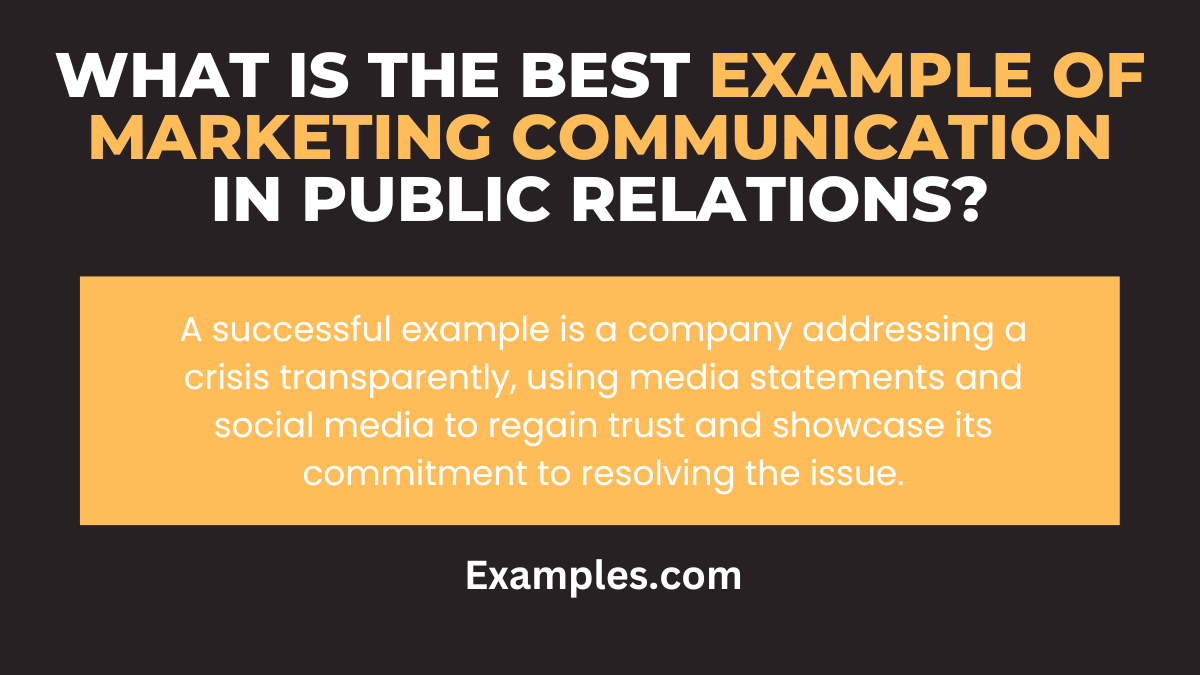
A standout example of Marketing Communication in Public Relations is the use of social media campaigns to manage a company’s image during a crisis. For instance, a firm might use Twitter and Facebook to quickly address customer concerns and provide updates on resolving the issue. This approach not only demonstrates transparency but also helps in maintaining customer trust and loyalty during challenging times.
Examples of Marketing Communication in Public Relations
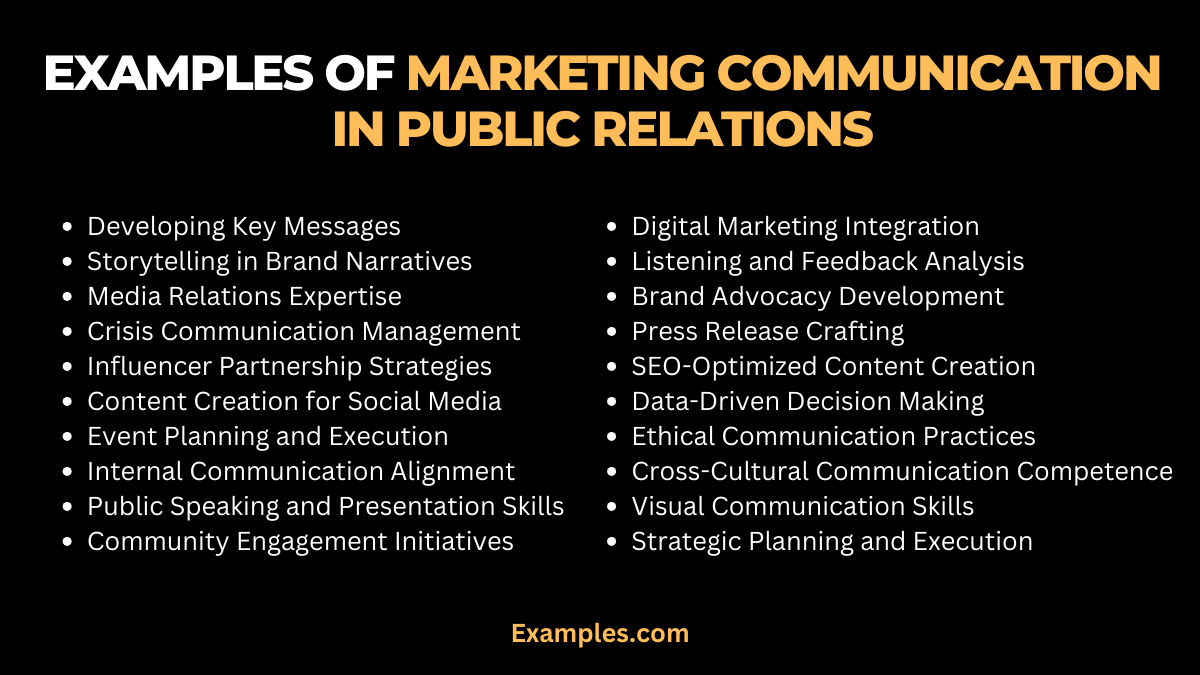
Understanding the intricate landscape of Marketing Communication in Public Relations involves exploring diverse strategies and channels. This article delves into 20 dynamic examples, each showcasing unique skills and approaches within the realm of marketing communication. From Influencer Marketing Communication to Direct Communication in Marketing, we unveil the subtleties of conveying messages effectively, aligning marketing communication objectives with public relations tactics to enhance brand visibility and audience engagement.
- Developing Key Messages: Crafting succinct, impactful messages that resonate with the target audience.
Example: “Our product ensures a sustainable future, merging innovation with responsibility.” - Storytelling in Brand Narratives: Using compelling stories to create a strong emotional connection with the audience.
Example: “Our journey started with a small idea that grew into a movement, changing lives one step at a time.” - Media Relations Expertise: Building and maintaining relationships with media personnel to enhance brand presence.
Example: “We regularly engage with journalists to share our latest innovations and community impact.” - Crisis Communication Management: Handling unexpected challenges with poise and clear communication.
Example: “In response to recent events, we have implemented measures to ensure the highest standards of safety.” - Influencer Partnership Strategies: Collaborating with influencers to extend brand reach and authenticity.
Example: “Our collaboration with renowned wellness experts underscores our commitment to health and wellbeing.” - Content Creation for Social Media: Tailoring engaging content for different social media platforms.
Example: “Discover the story behind our product through our latest Instagram series.” - Event Planning and Execution: Organizing events that effectively convey the brand’s message and values.
Example: “Join us for a unique experience that embodies our brand’s spirit of innovation.” - Internal Communication Alignment: Ensuring internal stakeholders are informed and on-board with PR strategies.
Example: “Our team is the heartbeat of our brand, and we keep them updated with regular internal newsletters.” - Public Speaking and Presentation Skills: Effectively communicating in public forums and events.
Example: “Our CEO’s keynote speech at the industry conference highlighted our technological advancements.” - Community Engagement Initiatives: Building strong community relations through active involvement and support.
Example: “We are committed to supporting local artists, showcasing their work in our corporate spaces.” - Digital Marketing Integration: Seamlessly incorporating digital strategies in public relations campaigns.
Example: “Our digital campaign complements our PR efforts, creating a cohesive brand message across platforms.” - Listening and Feedback Analysis: Actively listening to the audience’s feedback and integrating insights into communication strategies.
Example: “Customer feedback on social media helps us tailor our messages to better meet their needs.” - Brand Advocacy Development: Encouraging and nurturing brand advocates to amplify the brand’s message.
Example: “Our loyal customers are our best advocates, sharing their positive experiences with our brand.” - Press Release Crafting: Writing effective press releases that capture media attention and accurately convey key messages.
Example: “Our latest press release highlights the revolutionary impact of our new product line.” - SEO-Optimized Content Creation: Developing content that ranks well in search engines, enhancing online visibility.
Example: “Our blog posts are optimized for SEO, making it easier for potential customers to find us online.” - Data-Driven Decision Making: Utilizing data analytics to inform and refine communication strategies.
Example: “Data analysis from our recent campaign has helped us fine-tune our future marketing efforts.” - Ethical Communication Practices: Upholding ethical standards in all marketing communication efforts.
Example: “We adhere to strict ethical guidelines in our advertising, ensuring honesty and transparency.” - Cross-Cultural Communication Competence: Effectively communicating with diverse audiences, considering cultural nuances.
Example: “Our global campaigns are tailored to resonate with diverse cultural groups, respecting local customs.” - Visual Communication Skills: Using visual elements like images and videos to enhance message delivery.
Example: “Our visual ads are designed to be striking and memorable, aligning with our brand identity.” - Strategic Planning and Execution: Developing and implementing comprehensive marketing communication plans.
Example: “Our strategic plan outlines a roadmap for integrating PR activities with our overall marketing goals.”
Types of Marketing Communication in Public Relations
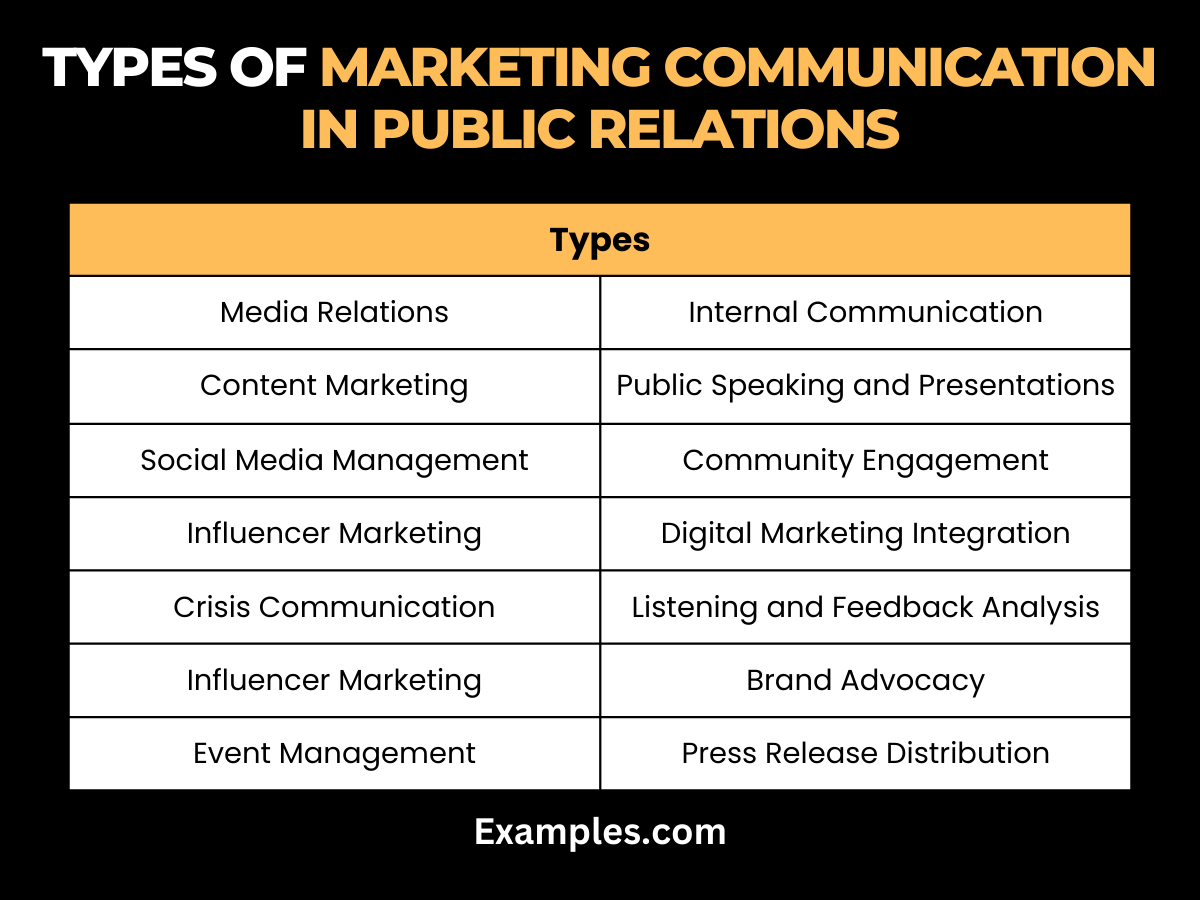
- Media Relations: Building relationships with journalists and media outlets to secure press coverage.
- Content Marketing: Creating valuable, relevant content to engage and inform the target audience.
- Social Media Management: Using social platforms for brand promotion, engagement, and communication.
- Crisis Communication: Managing and addressing crises or negative situations effectively.
- Influencer Marketing: Partnering with influencers to promote the brand.
- Event Management: Planning and executing events to connect with the audience.
- Internal Communication: Ensuring employees are informed and aligned with PR strategies.
- Public Speaking and Presentations: Representing the brand at conferences and events.
- Community Engagement: Involvement in community initiatives and support.
- Digital Marketing Integration: Combining PR efforts with digital marketing strategies.
- Listening and Feedback Analysis: Actively monitoring and responding to audience feedback.
- Brand Advocacy: Encouraging loyal customers to advocate for the brand.
- Press Release Distribution: Sharing news and updates with the media and public.
- SEO and Online Content: Optimizing content for search engines to enhance online visibility.
- Data Analytics: Using data to refine PR strategies and decision-making.
- Ethical Communication: Adhering to ethical standards in all communication efforts.
- Cross-Cultural Communication: Tailoring messages for diverse cultural audiences.
- Visual Communication: Utilizing visual elements for effective messaging.
- Strategic Planning: Developing comprehensive PR plans aligned with marketing goals.
Role of Marketing Communication in Public Relations
- Building Brand Awareness: Marketing communication plays a vital role in creating and increasing awareness about a brand among the public.
- Shaping Public Perception: It helps in shaping and controlling how the public perceives the brand, thereby influencing their opinions and attitudes.
- Crisis Management: Effective marketing communication is key in managing crises by controlling the narrative and minimizing damage to the brand’s reputation.
- Stakeholder Engagement: It enables the brand to effectively communicate and engage with various stakeholders, including customers, investors, and the media.
- Supporting Business Goals: Marketing communication aids in supporting broader business objectives, such as sales targets, market expansion, and customer retention.
- Establishing Thought Leadership: Through strategic communication, a brand can position itself as a thought leader in its industry.
- Enhancing Customer Relationships: It helps in building and maintaining strong relationships with customers, which is essential for long-term business success.
How is Public Relations Used in Marketing Communication?
- As a Trust-Building Tool: Public relations is used to build and maintain trust between the brand and its audience, a crucial aspect of marketing communication.
- Media Outreach: PR strategies often involve reaching out to media outlets to secure coverage, thereby amplifying the marketing message.
- Event Management: Organizing and participating in events is a common PR strategy that serves as a platform for marketing communication.
- Content Creation: PR involves creating compelling content that resonates with the audience, aligning with the brand’s marketing communication goals.
- Crisis Communication Management: In marketing communication, PR is critical in handling communication during a crisis to protect the brand’s image.
- Influencer Partnerships: Utilizing influencers for marketing communication is a PR tactic that leverages their credibility and audience reach.
- Feedback Loop: PR provides a feedback loop from the public to the company, informing marketing communication strategies.
Why is Public Relations Important in Marketing Communication?
- Enhances Credibility: Public relations boosts the credibility of marketing communications, as it relies on earned media rather than paid advertising.
- Wider Reach: PR extends the reach of marketing messages beyond traditional channels, tapping into a broader audience.
- Supports Brand Positioning: Through strategic PR, a brand can reinforce its positioning and key messages in the market.
- Manages Reputation: PR plays a crucial role in managing a brand’s reputation, which is integral to successful marketing communication.
- Facilitates Two-Way Communication: PR encourages dialogue between the brand and its stakeholders, making marketing communication more effective.
- Adapts to Market Changes: PR helps in quickly adapting marketing communication strategies to changing market dynamics and audience preferences.
- Integrates with Other Marketing Efforts: PR complements and integrates with other marketing efforts, ensuring a cohesive communication strategy.
Effective Marketing Communication in Public Relations plays a pivotal role in shaping brand identity and customer relations. By utilizing a diverse range of Marketing Communication Channels, organizations can create impactful messages that resonate with their audience. This integration ensures that every interaction with the brand contributes positively to building a cohesive and compelling brand narrative. Remember, the essence of successful marketing communication lies in its ability to engage, inform, and persuade, ultimately driving meaningful and lasting connections with the audience.



